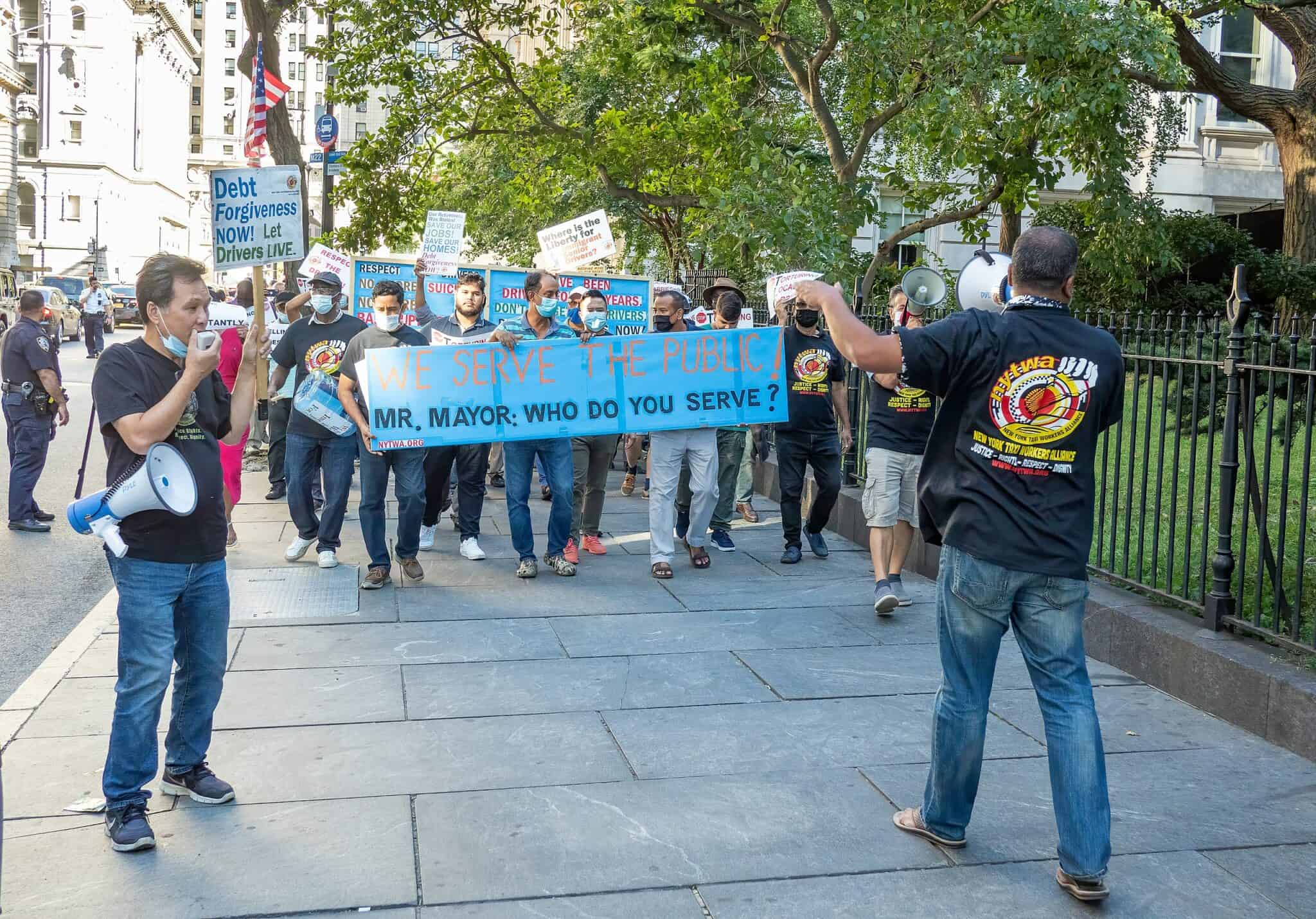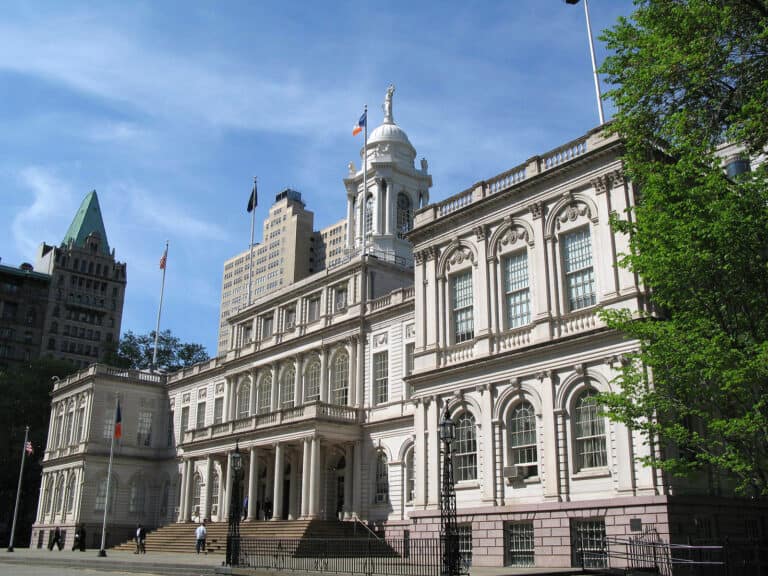
Travis Lavenski is a student at Harvard Law School.
Amidst a surge in collective action by workers at large companies such as John Deere, Kellogg’s, Warrior Met, etc. in what has been named “Striketober.,” organized labor won an important victory in the streets of our nation’s largest city. This November, after 46 days of protest, taxi drivers in New York successfully won a significant relief package for their crushing medallion debt. Before the deal was struck, taxi drivers held an average of over $550,000 in debt, with an estimate of between 4,000 and 6,000 medallion owners struggling to pay off their loans. The New York Taxi Workers Alliance (NYTWA), the union that represents over 21,000 drivers, organized a protest after taxi drivers refused to settle for a lukewarm offer from the city. The protest gained national media attention this October when dozens of taxi drivers went on a hunger strike. The November 3rd agreement requires Marblegate, the largest medallion lender, to restructure outstanding debt for taxi workers to a maximum principal of $200,000. Other medallion lenders are expected to follow suit. Additionally, the City will contribute $30,000 towards the principal of each driver’s debt. For the drivers, this means their debt is now effectively capped at $170,000, monthly payments at $1,122, and the City becomes the guarantor of all loans. This victory serves as a big win for drivers, of whom nearly 98% are immigrants. In all, the deal is estimated to eliminate hundreds of millions of dollars in debt owed by drivers, potentially saving some drivers from losing homes or even from taking their own lives. And as history has demonstrated, victories such these may serve as encouragement for other workers looking for fairer conditions.
How Did We Get Here?
The supply of taxi medallions, the ornate certificate required to drive a cab, is controlled and regulated by the City. Medallions are a tradeable asset, sold either privately or at public auction. For decades, they were seen as safe investment, sure to appreciate in value, and the ticket to achieving the American Dream. But, as a Pulitzer-Prize winning New York Times investigation revealed, this was a spoiled pitch. The medallion market was a bubble, sure to eventually burst. Competition from Uber and Lyft might have been the pin that popped the bubble, but industry insiders knew the truth: the crash was inevitable. All the while, multiple New York City Mayors turned the other way while thousands of taxi drivers were duped into signing predatory loans, enriching powerful industry players while ensnaring drivers in inescapable debt.
Malfeasance from the City is traced back to at least the Giuliani administration, when the Mayor “placed political allies inside the Taxi and Limousine Commission and directed it to sell medallions to help them balance budgets and fund priorities.” The City enticed prospective buyers with advertisements and misleading data, all the while encouraging price inflation. The City benefited immensely, making “more than $855 million” since 2002. And so, despite warnings of impending market collapse from City-hired taxi policy analysts in 2010, the practices persisted. The results were predictable. In 2002, medallions were valued at around $200,000; in 2014, just before the market bust, medallion prices soared to well over $1 million. In November 2021, medallions are valued at around $100,000. The mountain of debt persisted for drivers, however, as monthly payments climbed as high as $6,200.
Pleas for help largely fell on deaf ears. After 8 driver suicides in 2018 alone, the City Council responded by pitching mental health counseling and financial advice services. When faced with driver demands for financial assistance, the City cited the supposedly intolerable cost of a bailout.
The Debt Strike
With little help from the City and increasing pressure from competitors such as Lyft and Uber, drivers struggled immensely. Then came the pandemic, further amplifying drivers’ financial issues when many people stopped riding in cabs altogether. Eventually, drivers’ pleas for help became too loud for the City to ignore. In March 2021, Mayor Bill De Blasio, who himself was heavily supported by the taxi industry, announced a $65 million fund designed to help alleviate drivers’ debt. Drivers were not pleased, however, claiming the response to be a “roadmap to failure” and “a cash giveaway to the biggest lender in the industry.” The NYTWA countered with their own plan, supported by over 70 State and City elected officials and all of the City’s Federal Congresspersons, which capped driver debt at $145,000 and payments at $800/month. Mayor De Blasio would not be swayed, and largely dismissed the union’s proposal. “It’s really easy for folks to call for things that aren’t going to work and feel like, you know that sounds good.”
Mayor De Blasio pushed back against criticism by citing the success of his March 2021 proposal. For example, when Randal Wilhite, a lawyer for the New York Legal Assistance Group, exposed how the Mayor was exaggerating the success of his debt relief plan, the City responded by “threaten[ing] to pull NYLAG’s funding unless Wilhite was immediately removed from representing clients in the program.”
The City wasn’t listening, so the drivers did the only thing left to do. In late September, drivers picketed 24/7 outside City Hall calling for the TLC to take their demands seriously. After weeks on the line and shutting down the Brooklyn Bridge failed to work, the drivers took more drastic action. On October 19th, 11 drivers went on a hunger strike. Shortly after, more followed. In total, over 30 drivers and politicians survived on water, tea, and coconut juice for up to 15 days. The hunger strike picked up national attention, bringing publicity to driver suicides and the massive debt burden borne by drivers. Most importantly, it signaled to the City that the drivers meant business and would not back down until a fair solution was reached.
At 4:00 pm on November 3rd, the City caved. The new deal came close to the NYTWA’s initial proposal, and significantly reduced the debt burden for thousands of taxi drivers in New York. In a far cry from his initial dismissiveness of more robust plan, Mayor De Blasio called the new deal “an equitable, sustainable solution,” and claimed the City “refuse[d] to leave [taxi drivers] behind.”
It is unclear if taxi workers in other major cities, who faced similarly predatory loans from servicers who “developed their techniques in New York,” will find inspiration from this win, but rumblings from the twitter account of the San Francisco Taxi Workers Alliance seem to indicate a desire for similar debt relief in the wake of the NYTWA victory. One thing is for certain: for now, signs reading “no more suicides, no more bankruptcies,” will leave the City Hall lawns, and drivers can ditch the water for a proper meal knowing this stage of the battle has been won.







Daily News & Commentary
Start your day with our roundup of the latest labor developments. See all
July 7
LA economy deals with fallout from ICE raids; a new appeal challenges the NCAA antitrust settlement; and the EPA places dissenting employees on leave.
July 6
Municipal workers in Philadelphia continue to strike; Zohran Mamdani collects union endorsements; UFCW grocery workers in California and Colorado reach tentative agreements.
July 4
The DOL scraps a Biden-era proposed rule to end subminimum wages for disabled workers; millions will lose access to Medicaid and SNAP due to new proof of work requirements; and states step up in the noncompete policy space.
July 3
California compromises with unions on housing; 11th Circuit rules against transgender teacher; Harvard removes hundreds from grad student union.
July 2
Block, Nanda, and Nayak argue that the NLRA is under attack, harming democracy; the EEOC files a motion to dismiss a lawsuit brought by former EEOC Commissioner Jocelyn Samuels; and SEIU Local 1000 strikes an agreement with the State of California to delay the state's return-to-office executive order for state workers.
July 1
In today’s news and commentary, the Department of Labor proposes to roll back minimum wage and overtime protections for home care workers, a federal judge dismissed a lawsuit by public defenders over a union’s Gaza statements, and Philadelphia’s largest municipal union is on strike for first time in nearly 40 years. On Monday, the U.S. […]